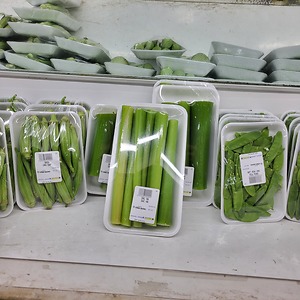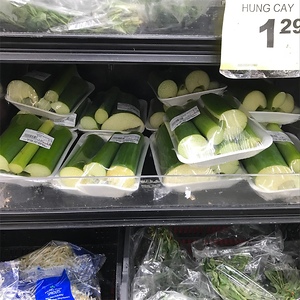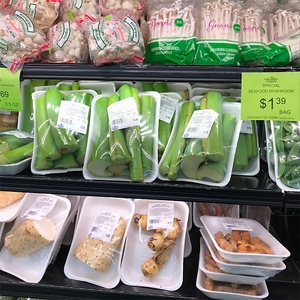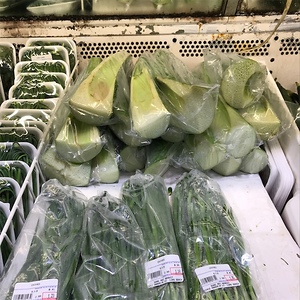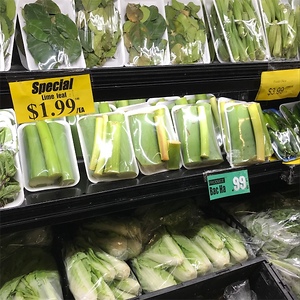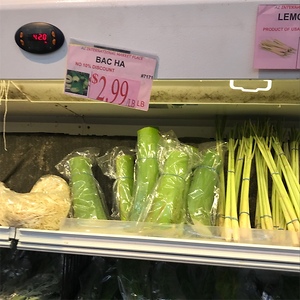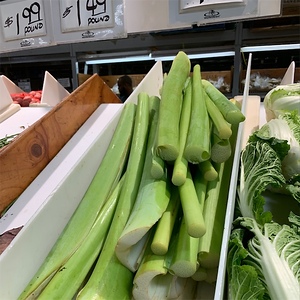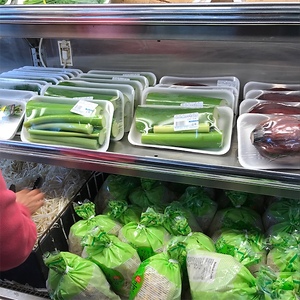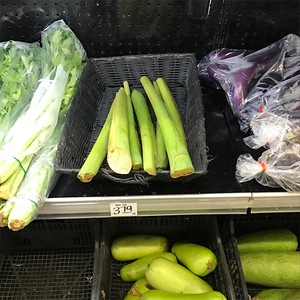

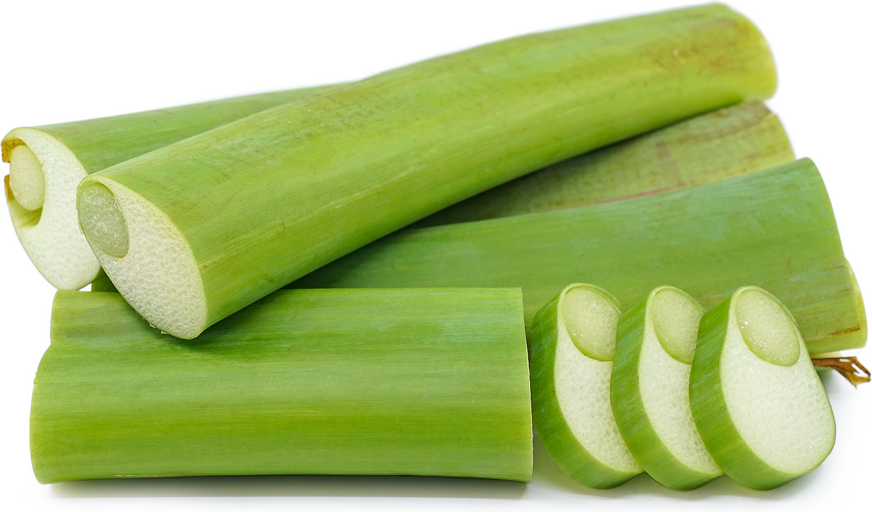
Bac Ha
Estimated Inventory, lb : 0
Description/Taste
Bac Ha is a lightweight, elongated stalk varying in size depending on growing conditions and maturity at harvest. The stalks are gathered and removed at the base of the plant and generally have a cylindrical to oval shape with a curved nature. The exterior of the stalk is covered in a semi-thick, fibrous layer that is lightly textured, taut, and green. This layer is typically peeled to reveal a white-to-ivory interior. The center of the stalk is comprised of a porous, web-like tissue that is spongy, airy, and firm. This structure is known as aerenchyma, a soft plant tissue found in semi-aquatic plants. Bac Hac is traditionally cooked before consumption as the stalks contain oxalates that may cause irritation among some consumers. Cooking the stalks dissipates oxalates and creates a more tender but still crisp texture. Bac Ha is known for its spongy texture rather than flavor and has a very mild and grassy taste with celery-like nuances. The hollow stalks are absorbent and readily take on accompanying flavors in culinary dishes.
Seasons/Availability
Bac Ha is available year-round in tropical climates.
Current Facts
Bac Ha, botanically classified as Colocasia gigantea, is the stalk of an herbaceous perennial plant belonging to the Araceae family. The species, in general, is known for producing some of the largest leaves and stalks within the Colocasia genus, and the towering evergreen plants can reach 1.5 to 3 meters in height. Colocasia gigantea is known as Giant Elephant Ear, Thailand Giant, Giant Taro, and Indian Taro, and this species is distinct from other species within the Araceae family as it is primarily grown for its stalks and leaves. Bac Ha is often referred to as the plant's stem, but anatomically, it is an elongated petiole, a stalk that connects the base of the leaf to the stem. The species is native to Asia but has spread worldwide as an ornamental addition to home gardens. Bac Ha is the name for Colocasia gigantea in Southern Vietnam, and the plant is known as Doc Mung in Northern Vietnam, Kan Thun, Ok Dip, Thoon, and O Dip in Thailand, and Hasu-Imo, Zuiki, Ryukyu, and Green Zuiki in Japan. In culinary preparations, Bac Ha is revered for its distinctly spongy, crisp, and absorbent properties and is typically incorporated into various soups to add texture.
Nutritional Value
Bac Ha has not been extensively studied for its nutritional properties. The stalks are said to be a source of fiber to regulate the digestive tract, iron to develop the protein hemoglobin for oxygen transport through the bloodstream, calcium to build strong bones and teeth, phosphorus to repair cell tissues, and zinc to protect the immune system against viruses and bacteria.
Applications
Bac Ha has a mild, grassy, green taste for cooked preparations. The stalks contain oxalates, also known as oxalic acids, that can cause allergic reactions and irritations to some consumers. These organic compounds are lessened when cooked, making Bac Ha a primarily boiled, blanched, or stir-fried ingredient. Bac Ha is also soaked in salt water before use. The stalks are customarily peeled to remove the fibrous exterior, and once prepped, they are sliced into smaller, angled pieces. Blanched Bac Ha is added to salads, or it is mixed into various stir-fries, especially throughout Southeast Asia. In Thailand, the stalks are incorporated into curries, and in Vietnam, they are used in a traditional dish called Canh Chua, which translates to “sour soup.” Canh Chua was created in the Mekong Delta region as a recipe to combine local vegetables with freshwater fish. The soup is often sweet, sour, and spicy and is prepared as an everyday staple meal. Beyond soups, Bac Ha is occasionally used in noodle dishes or pickled for extended use. In Japan, the stalks are thinly sliced and used as a base for sushi, or they are stirred into miso soup for added texture. Bac Ha pairs well with tamarind, herbs such as lemongrass, basil, and cilantro, aromatics including garlic, ginger, spring onions, and chile peppers, tomatoes, bok choy, carrots, coconut milk, and seafood such as shrimp, fish, and crab. Whole, unwashed Bac Ha will keep for around one week when stored in a sealed container in the refrigerator. It is recommended to immediately use the stalks after harvest or purchase for the best quality and flavor.
Ethnic/Cultural Info
Bac Ha is the name of the stalks of the Giant Elephant Ear plant, which is a treasured species throughout Southeast Asia. The plants are revered for their ability to grow to towering sizes, and if left to grow, they can be taller than the average person. The large arrow or heart-shaped leaves are also valued and considered by some Southeast Asian communities as a symbol of good fortune. The symmetrical heart shape is said to resemble two hands cupped together, open to receiving blessings and prosperity. Elephant Ear plants are often given as gifts to new businesses as a method to attract positive energy and new business. In home gardens, Elephant Ear plants are sometimes seen as a guardian species watching over the family and space they live in. They are also thought to provide calming energies and increased aesthetics in landscapes.
Geography/History
Bac Ha, or Colocasia gigantea, is thought to be native to Asia and has been growing wild since ancient times. Much of the species’ history is unknown, with some experts hypothesizing that it may be connected to a wild type of Colocasia or be a cross between several species. Various Colocasia species have been present throughout Southeast Asia for centuries, and over time, they were domesticated and cultivated as an ornamental and culinary crop, spreading to regions of the Mediterranean, Africa, Polynesia, and the Americas. Bac Ha was introduced from Vietnam to Hawaii sometime in the early 20th century, and in the 1980s, the species was being exported from Hawaii to California. Today, Bac Ha thrives in tropical, subtropical, and temperate climates worldwide, especially in Southeast Asia, and favors marshy, moist conditions. The stalks are sold through fresh markets and are left in large pieces or sliced and packaged into smaller quantities. Bac Ha is also popularly grown in home gardens worldwide as an ornamental.
Recipe Ideas
Recipes that include Bac Ha. One







